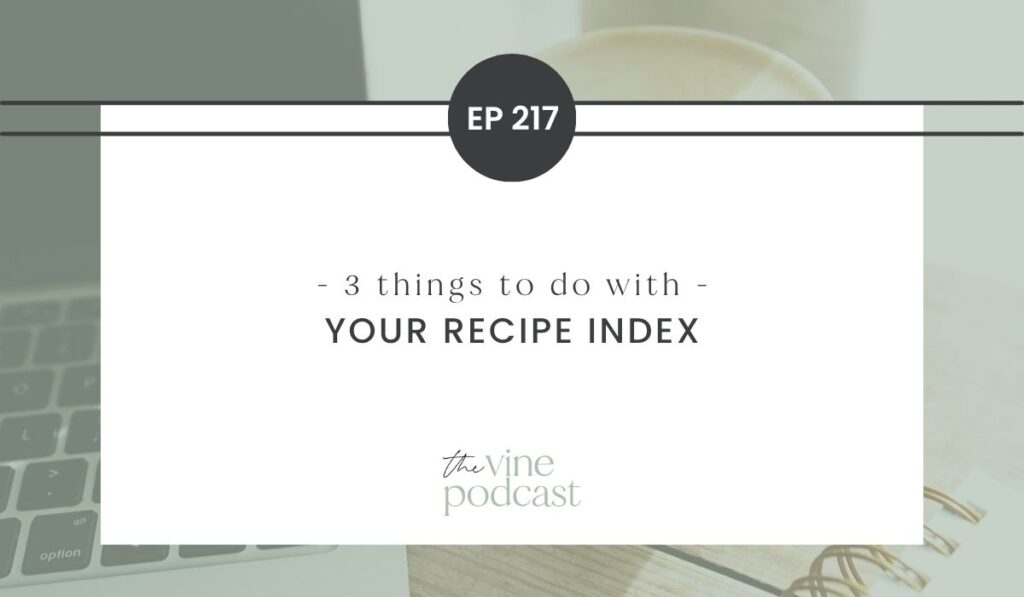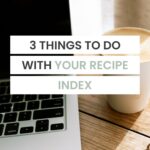When was the last time you actually looked at your recipe index page? If you’re like most food bloggers, it’s probably been a while – and there’s a good chance it’s not doing what you think it should be doing.
Your recipe index might be one of the most misunderstood pages on your entire website. Many food bloggers treat it like a traditional recipe box, trying to catalog every single recipe they’ve ever created. But here’s the thing: that approach is actually working against you, both for your readers and for Google.
If your recipe index feels overwhelming, confusing, or just plain ineffective, you’re not alone. Today we’re going to break down exactly what your recipe index should be doing and give you three simple changes that will make this page work harder for your blog.


The Truth About Recipe Indexes (It’s Not What You Think)
Let’s start with a mindset shift that might surprise you: your recipe index is primarily for Google, not for your readers.
I know this might feel counterintuitive. After all, isn’t your website supposed to be user-first? Absolutely – but when it comes to your recipe index specifically, understanding its true purpose will help you create something that actually serves both Google and your audience effectively.
Think about how people actually use your website. When someone lands on your blog looking for a specific recipe, do they scroll through your recipe index browsing hundreds of categories? Probably not. They’re much more likely to use your search function or navigate through your main menu.
Your recipe index serves a different purpose: it helps Google understand the structure and context of your site. It creates a roadmap that search engines can follow to better categorize and rank your content.
Focus on Categories, Not Individual Recipes
Here’s where many food bloggers go wrong: they try to list every single blog post or recipe on their recipe index page. This creates an overwhelming experience that doesn’t serve anyone well.
Instead, your recipe index should focus on showcasing your best and most robust categories.
What makes a category worth including?
- Fully optimized for SEO – Your category pages should have proper titles, descriptions, and SEO optimization
- Content-rich – Each category should have multiple high-quality posts, not just 2-3 recipes
- Representative of your brand – Focus on the categories that truly showcase what your blog is about
Why categories work better than individual posts:
- They create a clear site structure that Google can understand
- They help establish topical authority in your niche
- They’re less overwhelming for users who do browse your recipe index
- They’re easier to maintain as your blog grows
Think of your recipe index as creating a web of your content that helps Google connect the dots about what your blog covers and how your recipes relate to each other.

Make It Easy for Users to Actually Find What They Want
While your recipe index is primarily for Google, you can’t ignore the real people who might land on this page. The key is making it easy for them to quickly find what they’re looking for.
Add a search box to your recipe index page
This is such a simple addition, but it makes a huge difference for user experience. When someone lands on your recipe index, they’re probably looking for something specific. A prominent search box gives them the fastest path to finding it.
Keep the design simple and mobile-friendly
Your recipe index doesn’t need to be fancy or complex. In fact, simpler is usually better. Focus on:
- Clear, easy-to-read category names
- Clean layout that works well on mobile devices
- Fast loading times
- Logical organization
Remember, if someone can’t quickly find what they’re looking for, they’ll get frustrated and leave. A simple search box can save the day and keep visitors on your site.
Putting It All Together: Your Recipe Index Action Plan
Now that you understand the real purpose of your recipe index, here’s what you can do to optimize yours:
1. Reframe your thinking
- Remember: recipe index = primarily for Google
- Stop trying to catalog every single recipe
- Focus on creating clear site structure
2. Audit your categories
- Review which categories have the most content
- Ensure your featured categories are SEO-optimized
- Remove or consolidate categories with only a few posts
3. Improve user experience
- Add a search box to the page
- Simplify the design and layout
- Test the page on mobile devices
4. Regular maintenance
- Schedule time quarterly to review and update
- Add new categories as your content grows
- Remove outdated or thin categories
The Bottom Line: Simple Wins

Your recipe index doesn’t need to be complicated to be effective. In fact, the opposite is true. A simple, category-focused approach that includes a search function will serve both Google and your readers much better than an overwhelming catalog of every recipe you’ve ever posted.
The goal isn’t to create a comprehensive archive – it’s to create a clear, navigable structure that helps search engines understand your content and gives users a quick way to find what they need.
Take some time this week to look at your recipe index with fresh eyes. Ask yourself: does this page clearly communicate what my blog is about? Is it easy for someone to find what they’re looking for? Would Google be able to understand my site structure from this page?
If the answer to any of these questions is no, you know what to work on next.
Call to Action
If you’re feeling overwhelmed by all the different pages and elements that need attention on your food blog, you’re not alone. Consider scheduling a free consultation to discuss how a professional website audit could help you prioritize the changes that will make the biggest impact on your blog’s performance. What other pages on your website do you think might need a closer look?

ready to take your food blog to the next level?
We work with food bloggers looking to stand out of the crowd through custom brand and website design.




Hi Madison, I love the information you share with food bloggers. I am thrilled to have found your web site. I signed up for your free audit thing and I can’t wait to use it. My big fear is that I won’t be able to fix what I find out I need to fix. (sob) I am an 85 year old granny who was an English Prof and started a food blog in 2016 for folks with IBS. We have so many food issues and need so much help knowing what is and isn’t safe to eat. Thankyou for sharing in your podcasts issues that I can’t understand how to fix. Bless you for sharing.
Hi Joan! Thank you for your kind words and for signing up for the free audit. It’s wonderful to hear that you’re finding value in it.
Please don’t worry about fixing everything on your own. We’re here to help you navigate through any issues you might find. Remember, it’s a learning process and it’s okay to take it one step at a time.
Keep up the great work with your food blog. It’s truly inspiring to see your dedication to helping others with IBS navigate their food choices.